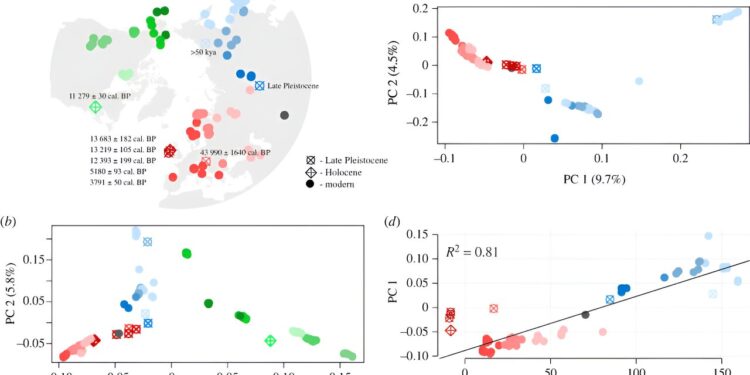Sampled brown bear locations and population structure. (a) Map showing the localities of ancient and contemporary brown bear genomes analyzed. The calibrated radiocarbon ages of ancient samples are listed next to their locality. “Late Pleistocene” next to Denisova_LP indicates that a direct age is unknown, but it is listed as Late Pleistocene in the original publication (26). CGG_1_020006 was dated beyond the radiocarbon dating limit (greater than 50 kya) but molecularly dated to 61,826 years BP (95% HPD: 27,866–96,783 years BP) (22). (b) PCA generated from genotype probabilities of all samples. (c) PCA generated from genotype probabilities of Eurasian samples only. Percentage values in parentheses on the X and Y axes indicate the percentage of variation explained by the principal component. (d) PC1 as a function of degrees of longitude for Eurasian individuals, excluding Japanese individuals. Colors and symbols represent geography and age respectively. The dark gray circle shows the single Himalayan individual. The color of Central Russia1 was changed to light red due to its geographical position in the Ural Mountains and its European-style grouping within the PCA. Credit: Proceedings of the Royal Society B: Biological Sciences (2024). DOI: 10.1098/rspb.2023.2411
The brown bear is one of the largest living terrestrial carnivores and is widely distributed throughout the northern hemisphere. Unlike many other large carnivores that became extinct at the end of the last ice age (cave bears, saber-toothed cats, cave hyenas), the brown bear is one of the lucky survivors that survived until nowadays. The question has intrigued biologists for almost a century: how was this so?
Brown bears are ecologically flexible and have a wide range of diets. Although they are carnivorous, their diet can also consist primarily of plant matter, making them adaptable to environmental changes. However, brown bears also experienced significant range reductions and regional extinctions during the last ice age. Brown bears once occupied a much wider range, including Ireland; Honshu, Japan’s largest island; and Quebec (Canada).
Did the decline or disappearance of bear populations in certain areas occur because bears left those places for better places where they still live now, or did unique groups of bears with Distinct genes inhabited these areas and disappeared, leading to a loss of overall diversity. of the species?
Studying the genomes of ancient brown bears between 3,800 and 60,000 years old, including several individuals from outside their current range, researchers from the University of Copenhagen, Denmark, and the University from Yamanashi, Japan, sought to answer this question by studying the evolution of the brown bear. relationships between brown bears across space and time.
Their research is published in the journal Proceedings of the Royal Society B: Biological Sciences.
Their study showed that brown bears did not simply move with the changing environment, but that their populations disappeared. “Our analyzes showed that ancient brown bears represent genetic diversity absent from current populations,” explains Takahiro Segawa, lead author of the study. “While brown bears have survived global extinction, they have suffered considerable losses in their historical range and genetic diversity.”
This new perspective highlights a crucial period in the history of brown bears and the fact that they also faced challenges during and after the last ice age.
“As we continue to address the challenges of coexistence between humans and wildlife, the lessons of the deep past are invaluable for shaping a sustainable future.” adds Michael Westbury, the lead author of the study. “While studying recent specimens can provide some information, by including samples from the past and from areas where a species no longer exists, we can better quantify how current diversity patterns arose and inform predictions about how they might respond to future environmental changes.”
More information:
Takahiro Segawa et al, The origins and diversification of Holarctic brown bear populations deduced from the genomes of past and present populations, Proceedings of the Royal Society B: Biological Sciences (2024). DOI: 10.1098/rspb.2023.2411
Provided by the University of Copenhagen
Quote: Ancient brown bear genomes shed light on losses and survival during the Ice Age (January 24, 2024) retrieved January 24, 2024 from
This document is subject to copyright. Apart from fair use for private study or research purposes, no part may be reproduced without written permission. The content is provided for information only.



